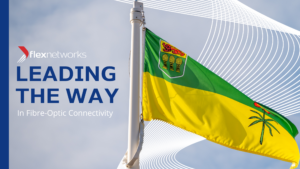In the contemporary hustle and bustle of the business landscape, the internet stands as an indispensable asset for enterprises, irrespective of their scale. Its multifaceted utility spans communication, marketing, research, and a myriad of other functions. As the need for swifter and more dependable online connectivity escalates, fibre-optic internet emerges as an ever-more-favoured option among businesses.
But what are the benefits of FlexNetworks fibre internet for your business? And is it worth investing in? In this blog, we will look at the cost-benefit analysis of fibre, various advantages of fibre internet, and how you can do your own cost-benefit analysis.
Cost-Benefit Analysis
When undertaking a cost-benefit analysis for your business, it’s essential to balance the investment in new technologies against the potential advantages they offer. This evaluation typically encompasses upfront installation costs, recurring service fees, and the expense of acquiring the necessary equipment. These expenditures are influenced by various factors, including your business’s size, the number of employees, location, and the internet speeds required for your operations.
A critical, yet often overlooked, element in this analysis is the cost of downtime, particularly for businesses heavily reliant on automated systems and cloud-based operations. Downtime costs can significantly differ among businesses, impacted by factors like lost productivity, missed opportunities, and customer satisfaction implications. For example, a manufacturing firm reliant on continuous internet connectivity might suffer production halts during downtime, leading to substantial financial losses and potential harm to customer relationships. Similarly, businesses that operate predominantly in the cloud can face severe disruptions, as access to critical data and applications is hindered, affecting every aspect of their operations from customer service to project management.
For businesses that depend on the cloud, the reliability and speed of fibre internet can mean the difference between smooth, uninterrupted operations and costly, disruptive downtime.
Investment in Reliability and Operational Efficiency
Investing in fibre-optic internet represents a strategic commitment to reliability and operational efficiency for businesses. The inherent stability of fibre-optic cables ensures a robust and consistent internet connection, minimizing the risk of disruptions and downtime. This reliability is particularly critical in today’s fast-paced digital landscape, where businesses heavily rely on seamless connectivity for communication, data transfer, and online operations.
With fibre internet, organizations can significantly reduce latency, optimize upload and download speeds, and enhance overall network performance. This heightened dependability translates into improved operational efficiency, allowing businesses to streamline processes, accelerate data-dependent tasks, and ultimately foster a more agile and responsive work environment. The upfront investment in fibre infrastructure pays dividends in terms of sustained reliability, positioning businesses to meet the evolving demands of a connected world with confidence and competitiveness.
Enhancement to Video Conferencing
Fibre internet introduces a transformative enhancement to the realm of video conferencing, revolutionizing the way businesses connect and collaborate virtually. The remarkable speed and bandwidth capabilities of fibre optics enable seamless, high-definition video streaming without the lag or buffering issues often associated with traditional internet connections. This translates into crystal-clear audio and sharp video quality, fostering a more immersive and engaging virtual meeting experience. With fibre internet, businesses can conduct video conferences with multiple participants concurrently, facilitating real-time communication, decision-making, and collaboration.
The low latency and symmetrical upload and download speeds of fibre-optic connections contribute to the fluidity of video conferencing, eliminating disruptions and ensuring that participants can contribute and interact in a natural, responsive manner. In essence, fibre internet not only addresses the technical challenges of video conferencing but elevates it to a level where remote collaboration becomes as efficient and dynamic as in-person meetings, thereby enhancing productivity and connectivity for modern businesses.
How Speed and Symmetry Boost Cloud-Based Operations
The speed and symmetry inherent in fibre play pivotal roles in elevating the efficiency and performance of cloud-based operations for businesses. The exceptional data transfer speeds of fibre ensure swift and seamless uploading and downloading of large volumes of data to and from the cloud. This expeditious process significantly reduces latency, enhancing the responsiveness of cloud-based applications. Moreover, the symmetrical nature of fibre internet, where upload and download speeds are nearly identical, is particularly advantageous for businesses engaged in collaborative and data-intensive tasks.
Whether it’s real-time collaboration on cloud-based documents, accessing and sharing multimedia content, or running complex applications, the symmetrical speeds of fibre internet contribute to a harmonious and balanced experience. This transformative capability not only optimizes workflow efficiency but also empowers businesses to fully harness the potential of cloud computing, fostering innovation, scalability, and seamless integration of cloud-based operations into the core of their digital strategies.
Long-Term Savings
Embracing fibre internet represents a forward-thinking investment that yields substantial long-term savings for businesses. Although the initial installation costs may be higher compared to traditional internet options, the efficiency gains and operational advantages delivered by fibre-optics contribute to significant savings over time. The enhanced speed and reliability reduce downtime, ensuring uninterrupted workflows and minimizing the potential financial losses associated with connectivity issues.
Moreover, fibre’s scalability allows businesses to adapt their bandwidth according to evolving needs without incurring extensive infrastructure overhauls. The symmetrical speeds of fibre-optics further optimize data-intensive tasks, fostering increased productivity and employee efficiency. As businesses increasingly rely on cloud services, video conferencing, and data-dependent applications, the resilience and performance of fibre-optic internet translate into tangible, long-term savings by maximizing operational efficiency, minimizing potential revenue loss, and future-proofing against the escalating demands of the digital landscape.
How to Approach a Cost-Benefit Analysis for Your Business
Conducting a comprehensive cost-benefit analysis for fibre-optic internet involves a systematic evaluation of both the initial investment and the long-term advantages it brings to the business. Here’s a step-by-step approach:
Identify Business Requirements:
Clearly define the specific internet needs of the business, considering the nature of operations, reliance on data-intensive applications, and the number of users.
Assess Installation Costs:
Evaluate the upfront costs associated with installing fibre-optic infrastructure, including the cost of fibre cables, networking equipment, and any necessary modifications to existing systems.
Evaluate Monthly Service Charges:
Compare the ongoing monthly subscription fees for fibre internet with alternative options. Consider the budgetary implications over an extended period.
Factor in Equipment Costs:
Account for any additional costs related to networking equipment. Assess whether existing equipment can be leveraged or if new, compatible devices are required.
Consider Scalability:
Analyze the scalability of fibre internet to accommodate future growth. Assess how easily the bandwidth can be adjusted to meet evolving business needs without significant additional costs.
Examine Reliability and Uptime:
Evaluate the potential impact of fibre on reliability, uptime, and the overall stability of the network. Consider how reduced downtime may contribute to operational efficiency and cost savings.
Quantify Time Savings:
Estimate the time savings associated with faster upload and download speeds, reduced latency, and improved overall network performance. Consider how increased operational efficiency translates into cost savings over time.
Assess Symmetrical Speeds:
Recognize the value of symmetrical speeds in tasks such as video conferencing, cloud-based operations, and collaborative work. Assess how this feature contributes to productivity gains.
Factor in Business Competitiveness:
Consider the competitive advantage gained by having reliable, high-speed internet. Evaluate how this can impact customer satisfaction, employee productivity, and the overall competitiveness of the business.
Compare Alternatives:
Conduct a thorough comparison with alternative internet options available in the area, weighing the benefits and drawbacks of each against the specific needs of the business.
Calculate ROI:
Estimate the return on investment (ROI) by comparing the identified benefits, such as improved efficiency and reduced downtime, with the total costs incurred over a defined period.
Consider Long-Term Savings:
Take into account the potential long-term savings resulting from increased efficiency, reduced downtime, and the adaptability of fibre internet to meet future business requirements.
Switching to FlexNetworks fibre is a breeze, causing little disruption and requiring only minor equipment adjustments. FlexNetworks is rapidly expanding its fibre coverage across the province, so check our network map to see if fibre is available in your area.
If you’re interested in discussing FlexNetworks business internet, please reach out to us by calling 1 (800) 724-8353, emailing us at info@flexnetworks.ca, or chatting with us through our website.




